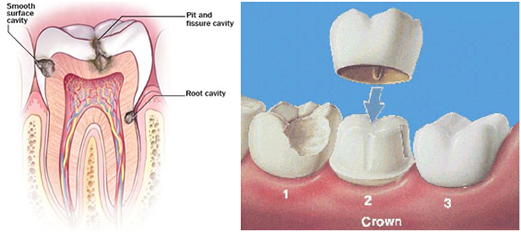I had to replace a crown on an a recent patient of mine the other day because of a cavity that occurred under an old crown. They were surprised to find out that it was possible for this to happen and thought this would be a great topic to address.
I would like to discuss how cavities form and then how they can get under a crown. My hope is that for those who don’t understand this would have a better understanding and it will eventually make more sense how his occurs. Cavities or dental caries form when calcified tooth structure looses its mineral content from constant exposure to plaque (bacteria) and sucrose (sugars).
Cosmetic Dentist in Shelby Discusses Dental Crowns and Cavities
If there are areas in the mouth that seem to accumulate food then it is probable that cavities will form. Food contains a mixture of simple and complex carbohydrates. Bacteria found in the mouth forms plaque and use these food products as a food source and as a by product they form acids. These acids dissolve the hard minerals in the teeth forming a soft dark mushy area. Cavities can develop on a natural tooth or where there is natural tooth exposed. Diets high in sugar put the patient at a high risk of forming these cavities. This, in combination with poor dental hygiene, put the patient at risk of requiring multiple fillings in their teeth.
As you can see on the left photo there are three areas where cavities form. (It is no coincidence that these are the areas where fillings are done).

1. In between adjacent teeth and on the smooth surface of the tooth: This is the location that is at risk when getting food caught between the teeth. Flossing on a regular basis helps prevent cavities in this area.
2. The biting surfaces or Pit and fissure: This is usually the first areas where cavities first form. Dental sealants are used to prevent cavities in these locations.
3. Root cavities take place in our geriatric patients who have had recession of the gums and bone.
When people age they are more likely to loose bone and this exposes the dentin (root) of the tooth. This is much softer and contains less mineral than the white enamel making it at higher risk of cavities. Combining this condition with the fact that dry mouth plagues most seniors. People who have a dry mouth are at risk of tooth decay because the saliva’s natural healing and remineralizing properties are not present. I usually find that they try to quench their thirst with high sugar containing drinks and candies. This is a deadly combination leading to a triple onslaught to the teeth therefore cavities are inevitable.
In fact, it seems like it is a constant battle to see patients who have a dry mouth (xerostomia) return to our office without a cavity. We usually have them on a fluoride rinse and tooth pastes to remineralize the teeth.
Dental Crowns cover the majority of a tooth but if a portion of the tooth becomes exposed then it is possible for cavities to form. (refer to the photo on the right) Those who have recession are at risk as discussed previously. It is also possible for food to get caught and wedged between adjacent teeth and even dental crowns if they do not have good contacts between them.
I would define a “good contact” when dental floss snaps as it passes between the teeth. This tight fit naturally prevents food from packing and keeps the soft tissues and teeth in good health. When this contact is inadequate from poorly made crowns, shifting teeth caused by missing teeth in the jaw or poorly done fillings it can be irritating when food gets packed in between the teeth. What is even worse is the fact that large cavities can form. In my experience these can grow fast without the patient even having a clue that they have a problem until it is too late. These can progress until one day they come into our office with a bad tooth ache, extremely swollen gums or a bad taste in the mouth.
One would assume that flossing would be enough to prevent problems that ensue when food is chronically getting caught between the teeth but the reality is that residual food particles just can’t be adequately washed away with brushing or flossing. If the above scenario describes you then don’t wait any longer. Get to your dentist and have it taken care of and if you don’t have a happy dental home then give us a call or visit our web site at TheGentleDentist.com. If you have any questions regarding this or have any areas in your mouth that require treatment or even a second opinion feel free to contact our office.
Cosmetic Dentist in Shelby Discusses Dental Crowns and Cavities
If you have a question about cosmetic dentistry or oral health or comment that I can post on the “Ask the Gentle Dentist” column please contact us by calling our Shelby dental office at (586)247-3500.
